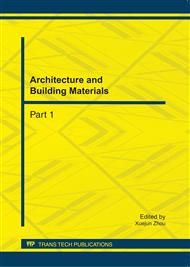p.1092
p.1096
p.1100
p.1106
p.1113
p.1117
p.1121
p.1128
p.1137
Green Concrete for Sustainable Life-Cycle
Abstract:
Green concrete is a concrete that supports the content of CO2 emissions reductions by using waste industries as cement replacement. The waste industries that commonly can be used in green concrete mixture design are fly ash, blast furnace slag, silica fume, and rice husk ash. The present of supplementary cementitous material in green concrete mixture can increase both compressive strength and cement efficiency. The higher of cement efficiency, the higher compressive strength and the lower cement content will be. Densified Mixture Design Algorithm (DMDA) is a method that has been widely applied to concrete constructions in Taiwan. DMDA method can support the higher of cement efficiency in green concrete design. By using DMDA to create green concrete with supplementary cementitous material can increase the life of concrete and hence reduce life-cycle cost.
Info:
Periodical:
Pages:
1113-1116
Citation:
Online since:
September 2011
Price:
Сopyright:
© 2011 Trans Tech Publications Ltd. All Rights Reserved
Share:
Citation:


